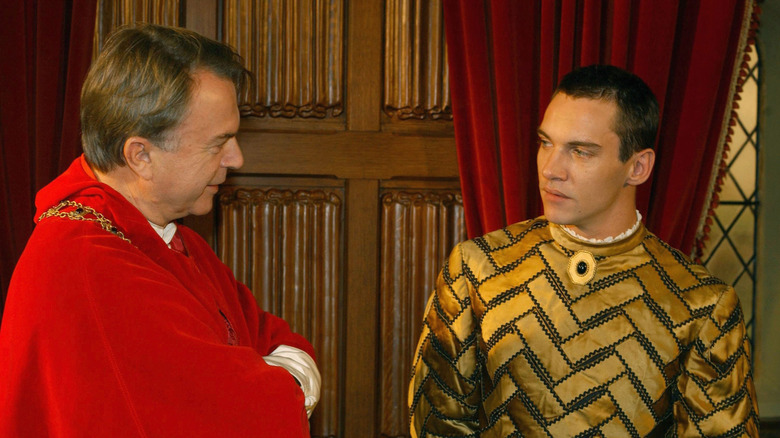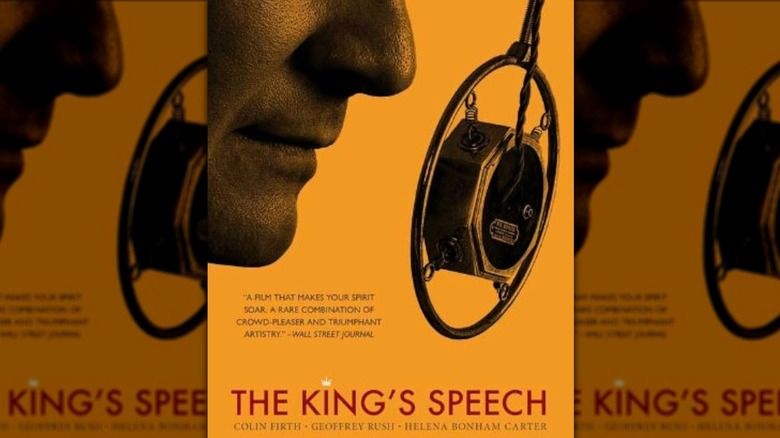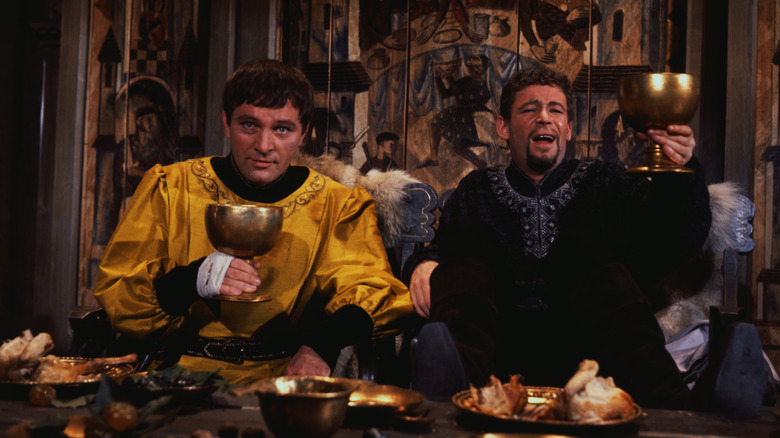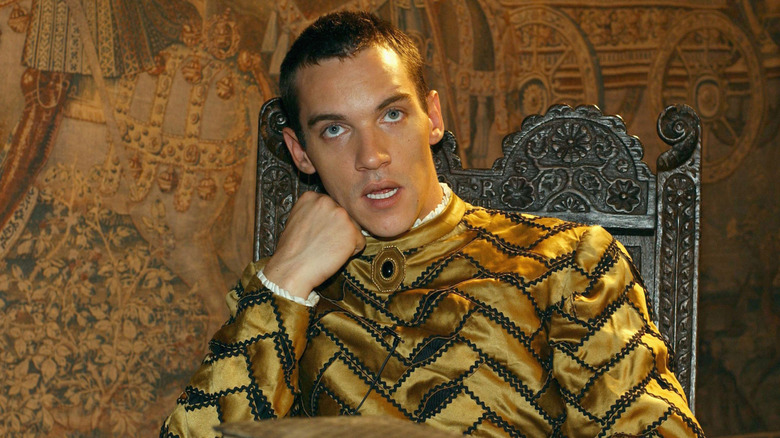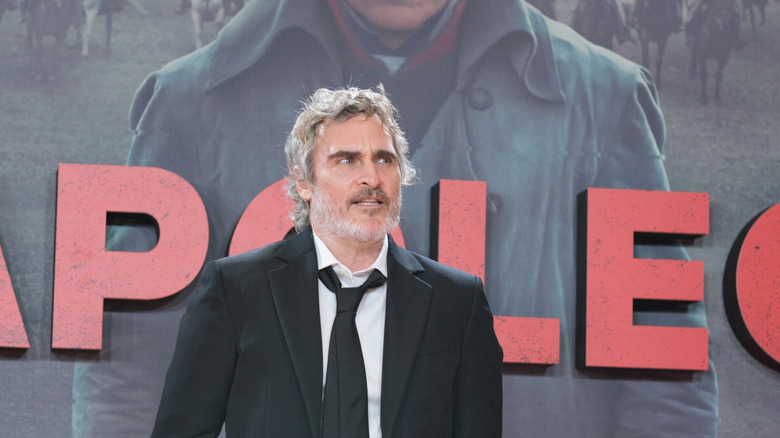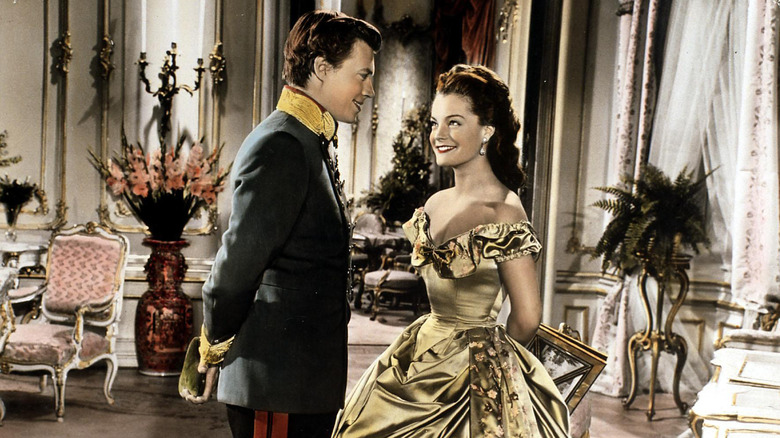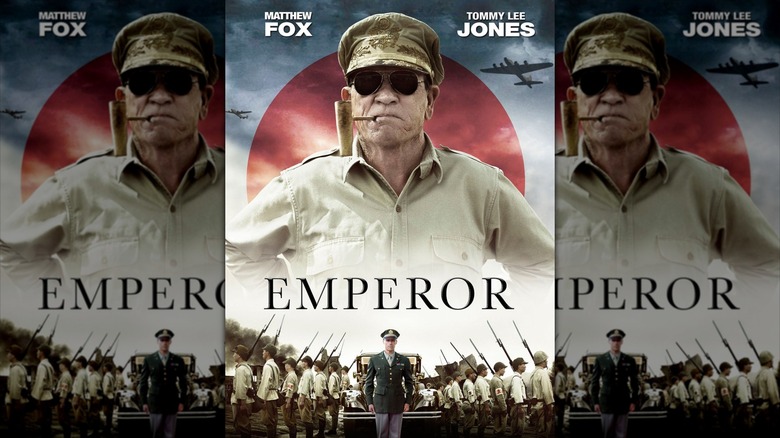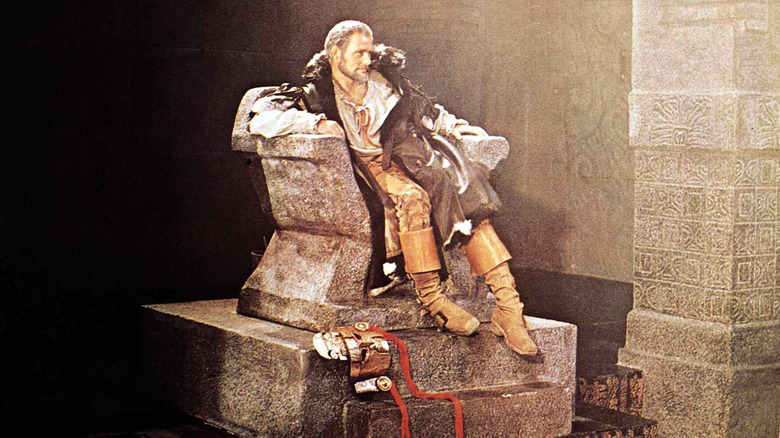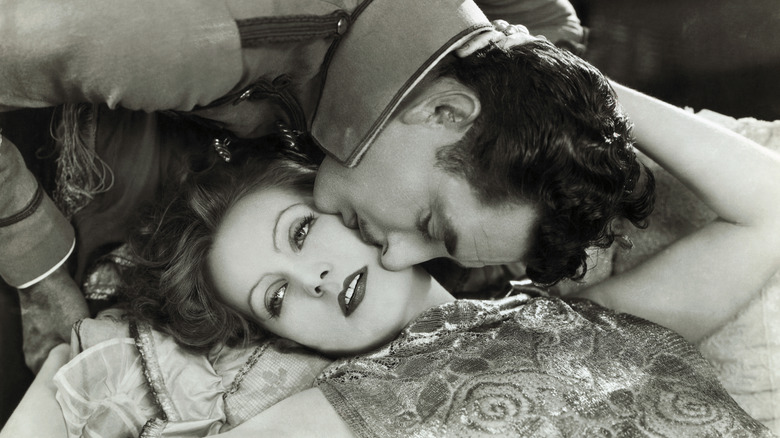Movies And TV Shows About Royals That Historians Absolutely Hate
It's easy to understand why royals are a perennially popular subject for historical dramas. They may be subject to the same loves, fears, and uncertainties as the rest of us, but they get to confront these issues in palaces, wearing elegant clothes, and until the advent of the modern bathroom, presumably while smelling a bit better than the hoi polloi. With both power and inbreeding prompting royals to grow outsize personalities great for scenery-chewing interpretation, auteurs often have all the inspiration they may need ready to roll.
But as we know, not every historical drama is created equal, and some that present themselves as true, or at least inspired by true stories, are less than textbook-accurate reports. Directors tempted by big budgets and bigger stories have sometimes asked if they could get away with a sexy Henry VIII, a happy Elisabeth of Austria, or an Atahualpa of the Incas played by Christopher Plummer in beige makeup. And they did get away with it in that these pictures were all made, but that grinding noise you hear is the sound of dozens of historians grinding their teeth to dust.
The King's Speech
"The King's Speech" presented a rare opportunity for Helena Bonham Carter to appear with her hair combed, but it's not good history. First of all, it significantly overstates the severity of the stutter King George VI spoke with. He did struggle with the speech impediment, but unlike some stutterers, was able to suppress it with concentration. In 1927, years before the titular speech, he had successfully addressed the Australian parliament, and existing recordings of the king reveal a difficulty speaking that is much less severe than the movie presents.
The movie also depicts the major members of the royal family as colder and crueler than they were to their intimates. Edward VII wasn't scary (or not to his grandchildren, at least), and George's mother Queen Mary was not the ice queen that's presented in "The King's Speech": She was the one who comforted George when it became clear his brother would abandon the throne and stick George with the heavy responsibility. Even the otherwise foul Edward VIII, a Nazi sympathizer who ditched his responsibilities in order to be free to marry another Nazi sympathizer, didn't bully his brother.
And finally, the Duchess of York, later Queen Elizabeth, and still later the Queen Mother, knew how elevators worked. She was a rich woman in one of the most advanced cities in the world, and by the 1930s, elevators were decades old.
Becket
Peter O'Toole played King Henry II of England twice: in "Becket" in 1964 and "The Lion in Winter" in 1968. "Becket" is less well remembered, at least in part because it doesn't star Katharine Hepburn. The film, based on a play by the French playwright Jean Anouilh, presents the friendship (and hinted romance) between Henry II and his friend Thomas Becket, which curdles into rivalry when Henry appoints Thomas as Archbishop of Canterbury. The tension between them leads to Becket's murder, perhaps at the king's orders.
The foremost failure of "Becket" is the meager roles it provides for Henry's mother and wife, Empress Matilda and Eleanor of Aquitaine, respectively. They're minor characters in the movie, but not in any credible history of 12th-century England. Empress Matilda fought a civil war to try to claim the English throne for herself and very nearly succeeded, while Eleanor had been on crusade with her first husband, the king of France, whom she divorced to marry the younger and sexier Henry. You'd never know these women were two of the biggest swashbucklers of their day by their timid depiction in "Becket," where the wildest thing they get up to is wearing very anachronistic headdresses.
The movie also makes Thomas a "Saxon," as in not part of the Norman ruling class that had come over with or after the Norman Conquest. Thomas Becket was, however, culturally and ancestrally Norman, so the movie tells a story about a culture clash that simply didn't occur.
The Tudors
It's not completely irrational to have cast the notably handsome Jonathan Rhys Meyers as Henry VIII in "The Tudors." The irritable, much-married monarch was an unusually tall, athletically built strawberry blond and considered very good-looking early in his reign, so Handsome Henry is accurate even if it's not how we think of the divorce addict today. Other aspects of "The Tudors" are much greater affronts to the historical record.
Much of the artistic license is the usual "sexing up" of history, throwing in a few extra affairs for Henry and his friend the Duke of Suffolk, including a big-if-true (but it's not) romp between Henry and Marguerite of Navarre, a sister of the king of France. The show makes a weirder decision when it combines Henry's sisters Margaret and Mary into a single sister, who may be kind of based on Mary but is named Margaret. This fictional sister marries the king of Portugal, but the real Tudor sisters had grander stories.
Margaret married the king of Scotland and played an active role in Scottish politics after the death of her husband, James IV, and it was her descendant James VI of Scotland who eventually became king when Elizabeth died. Mary was briefly queen of France before eloping with Charles Brandon, the Duke of Suffolk and one of Henry's friends. Not only is this story exciting, but the squabbling for power among these sister queens' descendants for power was politically important in the generations after Henry, but "The Tudors" didn't run enough seasons for that to become an issue.
Mary, Queen of Scots
One of the most profoundly frustrating factoids of Tudor history is that Queen Elizabeth and Mary, Queen of Scots never met. It's so tempting to imagine what these two striving, powerful women, one ultimately successful in holding her throne and the other not, would have said to each other if they'd had the chance. However, the risk-averse Elizabeth wasn't going to give the notoriously charming and seductive Mary an opportunity to cast a spell over more members of the English court or even Elizabeth herself, and the cousins' interaction was limited to letters. While 2018's "Mary, Queen of Scots" isn't the only film whose writers couldn't resist pretending, it's a forgivable sin for many viewers: Think of it as history as we wish it had been.
Less justifiable is the depiction of Mary's second husband, spoiled English lordling Lord Darnley, as a gay man. Darnley was an unpleasant character, and the mysterious circumstances of his murder puzzle armchair detectives even today, but he probably wasn't gay. Even if he had been, why present him as the lover of Mary's employee and confidant David Rizzio, whom he goes on to murder (in both the film and real life)? In real life, Darnley seemed to think Rizzio had gotten Mary pregnant (with the eventual King James of Bible fame).
Napoleon
By necessity, any film treatment of Napoleon's career will be a little cramped. The emperor of the French had a profoundly eventful life, to put it mildly, and trying to capture the French Revolution, his rise to the throne, his dominion over Europe, the disastrous invasion of Russia, the lonely years of exile, and everything in between would strain the screenwriter's craft and the bladder capacity of the average theatregoer. So instead of nitpicking Ridley Scott's ambitious "Napoleon," it's more efficient to focus on its worst sin: Napoleon did not order his troops to fire cannons at the Pyramid of Giza.
Napoleon did invade Egypt in 1798, before he was emperor, hoping to secure a French trade route in the Middle East and into Asia, and should the Fates smile, bother British possessions in Egypt. Napoleon's army took Alexandria easily and fought the Egyptian army at the Battle of the Pyramids, but the battle has that name because they were visible from the battle, not because they were casualties, and because it sounds even cooler than the Battle of Cairo. And for the record, when Napoleon's awed soldiers saw the Sphinx in person, it was already de-schnozzed: The gargantuan snout was missing by the mid-1700s, perpetrator unknown.
The Sissi Trilogy
Empress Elisabeth of Austria had a famously difficult life, at least for a beautiful, wealthy aristocrat. Restless and discontent her whole adulthood, haunted by the effect the aging process would have on her famed beauty, the anxious royal endured her only son's death in a mysterious murder-suicide, before Elisabeth herself fell to an assassin's knife. But if all you'd ever watched was the Sissi trilogy of films about Elisabeth's life, you'd have little idea of her real struggles.
The Sissi movies are a trilogy of films — "Sissi," "Sissi: The Young Empress," and "Sissi: The Fateful Years of an Empress" — produced in the late 1950s. The German-speaking world needed a postwar cheer-up, and actress Romi Schneider looked a lot like Elisabeth might have if she'd ever smiled in a photograph. A sweet-natured tomboy in the movies rather than the moody duchess of reality, Sissi scampers around Vienna, Hungary, and Venice (an Austrian possession for part of her husband's reign), charming everybody with her fresh-faced beauty and indomitable spirit. She solves political divisions by the mere magic of her presence, turning sceptical subjects into cheering royalists through her sheer Sissi-ness.
The movies have become a holiday tradition in German-speaking Europe, and they are fun if you like light love stories and ornate dresses, but they're not history.
Kingdom of Heaven
The Crusades are a long and grim chapter of history that pitted Christians and Muslims (and the occasional Mongol) against each other for control of the Holy Land. The Middle Eastern Crusades lasted for nearly 200 years, and so a movie about the Crusades has to do a lot of picking and choosing about what parts of the complex history they need to explain to tell a story.
But "Kingdom of Heaven" doesn't even get the geography right. When the central character lands on the eastern Mediterranean coast, he's faced with huge sand dunes that give way, eventually, to the "mountains" around Jerusalem. Modern Israel and Palestine are dry but not big arid wastes (especially not by the coasts), and Jerusalem is hilly, but "mountain" is a generous term for the terrain of the Old City.
"Kingdom" is also geared toward an audience with modern sensibilities about religious tolerance. Presenting a Christian character as arguing for the value of Jewish and Muslim traditions and sites of worship is, er, wildly anachronistic: There's a reason these are called the Crusades, not the "Meet-and-Greets." Violence to advance religious goals disgusts most audiences today, but it was simply part of how Crusaders (and their Muslim foes across the battle lines) saw the world. Tolerance is a modern concept, and while we may want to project it onto the past, doing so makes as much sense as having the Crusaders defend Jerusalem with AK-47s.
Emperor
We'll never know how much blame Japan's emperor Hirohito really deserved for the atrocities committed by his armies as they swarmed across Asia and the Pacific. Hirohito reportedly felt personally guilty in his old age, and historians increasingly point to aspects the emperor might have controlled. Ultimately, though, Hirohito wasn't tried for war crimes, a decision made by General Douglas MacArthur, the head of the post-war US occupation force.
"Emperor" dramatizes the inquiry into Hirohito's authority and actions that led to his avoiding prosecution. Unfortunately, it compresses a five-month investigation into 10 days of movie time to add suspense and distracts its main character — and the audience — with an extraneous love story. MacArthur is shown as a swaggering doofus, while the actual interrogator, General Bonner Fellers, was 49 and presumably mature enough to pause his pursuit of a local woman when he had an emperor to judge. Some historians even think Fellers slow-walked his investigation to allow the Japanese witnesses to close ranks, protect the emperor, and allow him to remain as a figure of continuity as Japan rebuilt, but this intriguing idea does not appear in "Emperor."
Oh, and the opening shot of the bombing of Hiroshima? That's actually footage of the bombing of Nagasaki.
Versailles
Whatever else you might say about the BBC 2 production "Versailles," you can't accuse it of dishonesty. The BBC itself provides an online guide to its lavish costume drama so that fans (and critics) can easily look up incidents from the series and see if they're fact — by the standards of a historical TV series — or made up for fun.
Perhaps most basically, the court didn't live at Versailles all the time, instead cycling through a series of royal palaces throughout the year per the royal whim, though you can forgive a budget-conscious producer for being reluctant to build enough sets for a show called "Versailles, Fontainebleau, and Saint Cloud." The primary villains of the show, who concoct a Protestant plot to kill Louis XIV, are completely fictitious, which the BBC guide describes as a conscious choice to allow them to be killed without complicating further seasons.
The rest is quibbling, really. Louis apparently loved flirting with his sister-in-law, his brother's English wife Henriette Anne, but it's unlikely to the point of being ludicrous that they would have consummated the winks and smiles. Henriette-Anne was probably not poisoned, though at the time of her death, people thought she had been. And the ballet Louis writes in a frantic fever haze is, unfortunately, pure fiction.
The Royal Hunt of the Sun
It was one of the dirtiest tricks in the whole sordid European conquest of the Americas. Having captured the Inca king Atahualpa, conquistador Francisco Pizarro demanded a colossal ransom, and once it was paid, he murdered the king anyway, after a show trial. This course was so slimy it even drew a rebuke from the king of Spain, in whose name all this was ostensibly being done.
And then to add insult to injury, in 1968 "The Royal Hunt of the Sun" came out. A young Christopher Plummer is painted as a sort of glossy sienna for the role of Atahualpa, which is offensive by modern standards and even not excellent makeup by the standard of 1968. The film's Pizarro is depicted less as the unscrupulous conqueror of recorded history but more as an everyday dude painted into a corner by the circumstances he finds himself in. Pizarro winds up liking Atahualpa (neither of them can read) and is reluctant to have him killed, only doing so at the behest of his men and fellow leaders of the expedition.
Changing a historical figure to tell an interesting story is not necessarily immoral, but if Pizarro had been as interested in how other people think as the movie depicts him to be, he probably wouldn't have been a conquistador. Humanizing a conqueror is one thing; whitewashing is another.
Queen Christina
Queen Christina of Sweden was an interesting enough character that moviemakers shouldn't really have to do much. A rare ruling woman in 17th-century Europe, Christina followed the beat of her own drum, governing Sweden according to her own priorities before abdicating, moving to Rome, and trying to become queen of Naples. And then of Poland. And then of Sweden again. Eventually, she gave up and became a patroness of the arts and a salon hostess, which suited her better.
Missing from all this is a "Mr. Christina of Sweden," which seems to be how she liked it. She was rumored to be involved with a cardinal later in her life, but even if they loved each other, there's no proof of a physical relationship. However, 1933's "Queen Christina" shoehorns two male suitors into Christina's life, though in fairness, the movie does also code Christina as queer. She stomps around in men's clothes and calls herself a "king" and a "bachelor," and even flirts with a female courtier whose character is based on a possible real romance Christina had. The strict Hays Code that governed American films meant that an openly gay Christina was as out of the question then as it was during the queen's life, but it's still a bit of a drag to watch the strapping woman king have to deal with boring old men.
